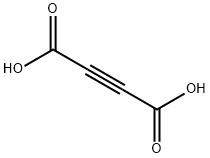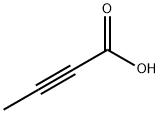2-Butyne
Synonym(s):Crotonylene;Dimethylacetylene
- CAS NO.:503-17-3
- Empirical Formula: C4H6
- Molecular Weight: 54.09
- MDL number: MFCD00009275
- EINECS: 207-962-2
- SAFETY DATA SHEET (SDS)
- Update Date: 2025-09-25 17:15:13

What is 2-Butyne?
Chemical properties
clear colorless to light yellow liquid
The Uses of 2-Butyne
2-Butyne is used to synthesize alkylated hydroquinones in the total synthesis of Vitamin E. It is also used as pharmaceutical intermediates.
General Description
A clear colorless liquid with a petroleum-like odor. Flash point below -4°F. Boiling point 81°F. Less dense than water and insoluble in water. Vapors heavier than air.
Air & Water Reactions
Highly flammable. Insoluble in water.
Reactivity Profile
2-Butyne may react vigorously with strong oxidizing agents. May react exothermically with reducing agents to release hydrogen gas. In the presence of various catalysts (such as acids) or initiators, may undergo exothermic addition polymerization reactions.
Hazard
Flammable, dangerous fire risk. Moderate explosion hazard.
Health Hazard
Inhalation or contact with material may irritate or burn skin and eyes. Fire may produce irritating, corrosive and/or toxic gases. Vapors may cause dizziness or suffocation. Runoff from fire control or dilution water may cause pollution.
Safety Profile
A simple asphyxiant. Very dangerous fire hazard when exposed to heat or flame; can react with oxidzing materials. Moderately explosive in the form of vapor when exposed to heat or flame. To fight fire, use foam, CO2, dry chemicals. See also ACETYLENE COMPOUNDS and ARGON (for a description of simple asphyxiants).
Purification Methods
Stand it over sodium for 24hours, then fractionally distil it under reduced pressure into a cooled receiver. [Beilstein 1 IV 971.]
Properties of 2-Butyne
| Melting point: | -32 °C |
| Boiling point: | 27 °C(lit.) |
| Density | 0.691 g/mL at 25 °C(lit.) |
| vapor pressure | 11.47 psi ( 20 °C) |
| refractive index | n |
| Flash point: | -25 °C |
| storage temp. | 2-8°C |
| form | Liquid |
| color | Clear colorless to light yellow |
| Specific Gravity | 0.691 |
| Water Solubility | Not miscible in water. |
| BRN | 1361340 |
| CAS DataBase Reference | 503-17-3(CAS DataBase Reference) |
| EPA Substance Registry System | 2-Butyne (503-17-3) |
Safety information for 2-Butyne
| Signal word | Danger |
| Pictogram(s) |
 Flame Flammables GHS02  Exclamation Mark Irritant GHS07 |
| GHS Hazard Statements |
H224:Flammable liquids H315:Skin corrosion/irritation H319:Serious eye damage/eye irritation H335:Specific target organ toxicity, single exposure;Respiratory tract irritation |
| Precautionary Statement Codes |
P210:Keep away from heat/sparks/open flames/hot surfaces. — No smoking. P302+P352:IF ON SKIN: wash with plenty of soap and water. P305+P351+P338:IF IN EYES: Rinse cautiously with water for several minutes. Remove contact lenses, if present and easy to do. Continuerinsing. P403+P233:Store in a well-ventilated place. Keep container tightly closed. |
Computed Descriptors for 2-Butyne
New Products
4,4-Difluoropiperidine hydrochloride tert-butyl 9-methoxy-3-azaspiro[5.5]undecane-3-carboxylate Indole Methyl Resin N-Isopropylurea N,N-Dicyclohexylcarbodiimide(DCC) MELDRUMS ACID 5-METHYLISOXAZOLE-4-CARBOXYLIC ACID Magnessium Bis glycinate Zinc ascorbate 1-bromo-2-butyne 2-acetamidophenol 9(10H)-anthracenone Erythrosin B, 4-Piperidinopiperidine 2-((4-morpholinophenylamino) (methylthio) methylene) malononitrile 2,4-dihydroxybenzaldehyde 3-(4-morpholinophenylamino)-5-amino-1H-pyrazole-4-carbonitrile Methyl 2-methylquinoline-6-carboxylate 2,6-dichloro-4-nitropyridine 4-Bromo-2-chlorobenzonitrile 2-(benzylamino)acetic acid hydrochloride 4-(tert-Butoxycarbonylamino)but- 2-ynoic acid 3,4-dihydro-2H-benzo[b][1,4]dioxepine 1-Phenyl-1-cycloprppanecarboxylicacidRelated products of tetrahydrofuran








You may like
-
 2-Butyne CAS 503-17-3View Details
2-Butyne CAS 503-17-3View Details
503-17-3 -
 3-(4-amino-1-oxoisoindolin-2-yl)-1-methylpiperidine-2,6-dione 98%View Details
3-(4-amino-1-oxoisoindolin-2-yl)-1-methylpiperidine-2,6-dione 98%View Details -
 614-19-7 98%View Details
614-19-7 98%View Details
614-19-7 -
 3112-85-4 Methyl phenyl sulfone 98%View Details
3112-85-4 Methyl phenyl sulfone 98%View Details
3112-85-4 -
 20677-73-0 (2,2-diethoxyethyl)methylamine 98%View Details
20677-73-0 (2,2-diethoxyethyl)methylamine 98%View Details
20677-73-0 -
 3-(4-(hydroxyamino)-1-oxoisoindolin-2-yl)piperidine-2,6-dione 98%View Details
3-(4-(hydroxyamino)-1-oxoisoindolin-2-yl)piperidine-2,6-dione 98%View Details -
 57381-49-4 2-bromo-4-chlorobenzonitrile 98%View Details
57381-49-4 2-bromo-4-chlorobenzonitrile 98%View Details
57381-49-4 -
 4,6-dichloropyrimidine-5-carbaldehyde 98%View Details
4,6-dichloropyrimidine-5-carbaldehyde 98%View Details
5305-40-8
